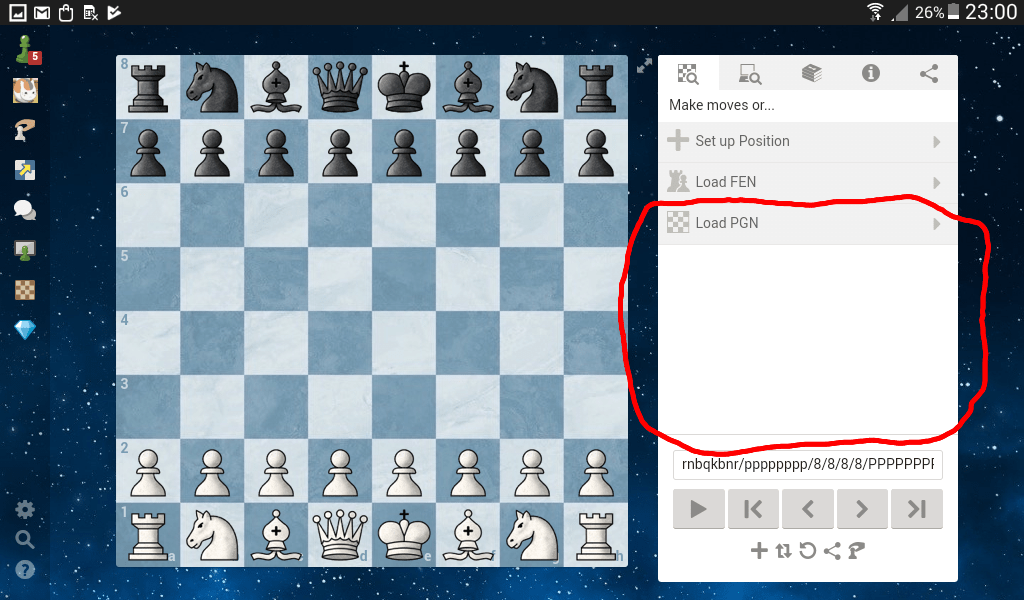

- WHAT IN PGN CHESS FILE INDICATES WHICH SIDE IS TO MOVE PORTABLE
- WHAT IN PGN CHESS FILE INDICATES WHICH SIDE IS TO MOVE SOFTWARE
The format should be such that it can be used by chess database programs, chess publishing programs, chess server programs, and chessplaying programs without being unnecessarily specific to any particular application class.Ĥ) The system must be easily expandable and scalable.
WHAT IN PGN CHESS FILE INDICATES WHICH SIDE IS TO MOVE SOFTWARE
The idea is to let chess programmers compete in a free market where customers may choose software based on their real needs and not based on artificial requirements created by a secret data format.ģ) The system must work for a variety of programs. Ideally, if the documentation is not available for some reason, typical chess software developers and users should be able to understand most of the data without the need for third party assistance.Ģ) The details of the system must be non-proprietary so that users and software developers are unrestricted by concerns about infringing on intellectual property rights. These criteria include:ġ) The details of the system must be publicly available and free of unnecessary complexity. The design criteria for PGN were selected to meet these needs.
WHAT IN PGN CHESS FILE INDICATES WHICH SIDE IS TO MOVE PORTABLE
Finally, some other software may work very well for many purposes, but it uses symbols and language not easily understood by people or computers available to those outside the country of its development.Ī specification for a portable game notation must observe the lessons of history and be able to handle probable needs of the future. Another software producer may develop a non-proprietary system, but it may work well only within the scope of a single program or application because it is not easily expandable. Sometimes a designer may produce a format that can be deciphered without too much difficulty, but at the same time publicly discourage third party software by claiming trade secret protection. Sometimes a manufacturer deliberately designs a data format using encryption or some other secret, proprietary technique to "lock in" a customer. In fact, most of them are correlated with the same problems that have already been seen with commercial software offerings for other domains such as word processing, spreadsheets, fonts, and graphics. The reasons for format incompatibility are easy to understand. Sometimes these problems become more visible when a user attempts to move significant quantities of data from one program to another if there has been no real effort to ensure portability of data, then the chances for a successful transfer are small at best. Unfortunately, many programs have had serious problems with several aspects of the external representation of chess game data. Some of these programs are rather impressive most are now well behaved in that they correctly follow the Laws of Chess and handle users' data with reasonable care. The idea is to allow the construction of a family of chess applications that can quickly and easily process chess game data using PGN for import and export among themselves.Ĭomputer usage among chessplayers has become quite common in recent years and a variety of different programs, both commercial and public domain, are used to generate, access, and propagate chess game data. Instead, PGN is proposed as a universal portable representation for data interchange. PGN is not intended to be a general purpose standard that is suitable for every possible use no such standard could fill all conceivable requirements. The intent of the definition and propagation of PGN is to facilitate the sharing of public domain chess game data among chessplayers (both organic and otherwise), publishers, and computer chess researchers throughout the world.

PGN is structured for easy reading and writing by human users and for easy parsing and generation by computer programs. PGN is "Portable Game Notation", a standard designed for the representation of chess game data using ASCII text files.


 0 kommentar(er)
0 kommentar(er)
